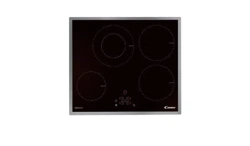Loading ...
Loading ...
Loading ...

Positions Some Tips
1
2
3
4
5
6
Very Low
Low
Moderate
Medium
High
Very High
To keep a dish hot, melt butter and chocolate...
Slow cooking, sauces, stews, rice pudding
poached eggs...
Beans, frozen foods, fruit, boiling water...
Steamed apples, fresh vegetables, pasta,
crepes, fish...
More intense cooking, omelettes, steaks...
Steaks, chops, frying...
1-2
3-4
5-6
7-8
9-10
11-12
HOW TO OPERATE THE HOB:
• Locate the sign corresponding to the cooking zone that you
need.
• Turn the control knob to the required cooking setting.
Initially we recommend that the heat zone be set at the highest
position until such times as the contents of the saucepan have
reached the required temperature, the heat can then be reduced
to the required cooking setting.
• The residual heat indicator light is illuminated when the hob
surface temperature reaches 60 degrees or above. It will
remain on even if the hob is switched off and will only go out
when the hob surface has cooled down.
• To switch off the hob, turn the knob to "0".
Warning : The extra large highlight zone, will depending upon
the dimensions of the cookware and/or the quantity of food being
cooked provide even higher levels of performance.
* The oval heating zone consists of two heating areas, a
circular area with a complementary oval shaped section.
Turn the control knob from 1 to 12 to regulate the circular area.
To operate the oval section, simply turn the control knob to position
12 and then select a position from 1 to 12.
* The heating area consists of two concentric zones.
The inner circle is activated when the knob is turned to any of the
positions from 1 to 12.
The outer ring will only be activated when the control is turned
beyond 12 up to a power of 2200 W.
• VITROCERAMIC HOB WITHOUT CONTROL KNOBS “PVS”
10 GB
HOW TO OPERATE THE GLASS CERAMIC HOB
HOB COOKWARE ADVICE
• Always use good quality cookware with perfectly flat and
thick bases : using this type of cookware will prevent hot spots
that cause food to stick. Thick metal pots and pans will provide
an even distribution of heat.
• Ensure that the base of the pot or pan is dry : when filling
pans with liquid or using one that has been stored in the
refrigerator, ensure that the base of the pan is completely dry
before placing it on the hob. This will help to avoid staining the hob.
• Use pans whose diameter is wide enough to completely
cover the surface unit : the size of the pan should be no smaller
than the heating area. If it is slightly wider the energy will be
used at its maximum efficiency.
THE CHOICE OF COOKWARE - The following information will
help you to choose cookware which will give good performance.
Stainless Steel :
highly recommended.
Especially good with a
sandwich clad base. The sandwich base combines the benefits
of stainless steel (appearance, durability and stability) with the
advantages of aluminium or copper (heat conduction, even heat
distribution).
Aluminium :
heavy weight recommended.
Good conductivity.
Aluminium residues sometimes appear as scratches on the hob,
but can be removed if cleaned immediately.
Because of its low melting point, thin aluminium should not be
used.
Cast Iron :
usable, but not recommended.
Poor performance.
May scratch the surface.
Copper Bottom / stoneware:
heavy weight recommended.
Good
performance, but copper may leave residues which can appear
as scratches. The residues can be removed, as long as the hob
is cleaned immediately. However, do not let these pots boil
dry. Overheated metal can bond to glass hobs. An overheated
copper pot will leave a residue that will permanently stain the hob.
Porcelain/enamel : Good perfomance only with a thiny smooth,
flat base.
Glass-ceramic :
not recommended.
Poor performance. May
scratch the surface.
Using good quality cookware is critical for setting the best
performance from your hob.
• Locate the sign corresponding to the cooking zone that you need:
Each surface unit is regulated by a control knob which provides
access to any power levels.
• It is recommended that heat setting is at its highest until it has
properly warmed up and then lower to the desired cooking setting.
• The residual heat indicator lights up when the heat zone
temperature reaches 60°C and above. It will stay on, even if the
unit is switched off, until the surface has cooled down. It will
switch off when the temperature of the heat zone falls below 60°C.
• To switch off an heat zone, turn the corresponding knob back
on the "0" setting.
• Positions : the examples below are intended as a guide. When
you become familiar with using your hob you will be able to work
out the settings which suit you best.
• VITROCERAMIC HOB WITH CONTROL KNOBS “PVK”
1 Very low To keep a dish hot, melt butter and chocolate...
2 Low Slow coocking, sauces, stews, rice pudding, poached eggs...
3 Moderately Beans, frozen foods, fruit, boiling water...
4 Medium
Steamed apples, fresh vegetables, pasta, crepes, fish...
5 Higt More intense coocking, omelettes, steaks...
6 Very higt Steaks, chops, frying...
Positions Some tips...
• After powering up the hob, wait some seconds to activate the
electronic controls.
• PRESENTATION TOUCH SENSITIVES CONTROLS
VITROCERAMIC HOB WITH SENSITIVES CONTROLS "PVD"
Additional cooking
zone led*
* according to model.
Control Led
Cooking zone programming indicator*
- Press the button .
Electronic control of the hob is activated. In each display zone
the heat level is displayed and the control LED blinks.
- After 20 seconds whithout use, the electronic control goes off
and the starting operation has to be repeated.
Loading ...
Loading ...
Loading ...
